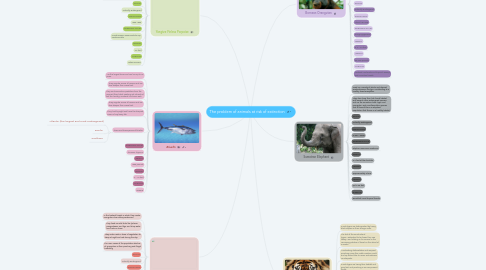The problem of animals at risk of extinction
da Sofia Siachoque Puerto


1. Yangtze Finless Porpoise
1.1. The Yangtze River, the longest river in Asia, used to be one of the only two rivers in the world that was home to two different species of dolphin
1.1.1. The Yangtze finless porpoise
1.1.2. The Baiji dolphin
1.2. However, in 2006 the Baiji dolphin was declared functionally extinct.
1.3. Is known for its mischievous smile and has a level of intelligence comparable to that of a gorilla.
1.4. STATUS
1.5. Critically Endangered
1.6. POPULATION
1.7. 1000-1800
1.8. SCIENTIFIC NAME
1.9. Neophocaena asiaeorientalis ssp. asiaeorientalis
1.10. LENGTH
1.11. 6.2 feet
1.12. HABITATS
1.13. Lakes & Rivers
2. Bluefin
2.1. Are the largest tunas and can live up to 40 years.
2.2. They migrate across all oceans and can dive deeper than 3,000 feet.
2.3. They are tremendous predators from the moment they hatch, seeking out schools of fish like herring, mackerel, and even eels.
2.4. They migrate across all oceans and can dive deeper than 3,000 feet.
2.5. They hunt by sight and have the sharpest vision of any bony fish.
2.6. There are three species of bluefin:
2.6.1. Atlantic (the largest and most endangered)
2.6.2. Pacific
2.6.3. Southern
2.7. SCIENTIFIC NAME
2.8. Thunnus Thynnus
2.9. WEIGHT
2.10. 1500 pounds
2.11. LENGTH
2.12. 6 - 10 feet
2.13. HABITATS
2.14. Oceans
3. Orangutan
3.1. In the lowland forests in which they reside, orangutans live solitary existences.
3.2. They feast on wild fruits like lychees, mangosteens, and figs, and slurp water from holes in trees.
3.3. They make nests in trees of vegetation to sleep at night and rest during the day.
3.4. The main cause of the population decline of orangutans is their poaching and illegal trafficking
3.5. STATUS
3.6. Critically Endangered
3.7. POPULATION
3.8. about 104,700 (Bornean), 13,846 (Sumatran), 800 (Tapanuli)
3.9. SCIENTIFIC NAME
3.10. Pongo abelii, Pongo pygmaeus
3.11. WEIGHT
3.12. up to 200 pounds
4. Bornean Orangutan
4.1. Bornean orangutan populations have declined by more than 50% over the past 60 years, and the species' habitat has been reduced by at least 55% over the past 20 years.
4.2. The Bornean orangutan differs in appearance from the Sumatran orangutan, with a broader face and shorter beard and also slightly darker in color.
4.3. Three subspecies are recognized, each localized to different parts of the island:
4.3.1. Northwest Bornean orangutans are the most threatened subspecies. Its habitat has been seriously affected by logging and hunting, and a mere 1,500 individuals or so remain.
4.3.2. Northeast Bornean orangutans are the smallest in size and found in Sabah and eastern Kalimantan as far as the Mahakam River.
4.3.3. Central Bornean orangutans are the subspecies with the most animals, with at least 35,000 individuals.
